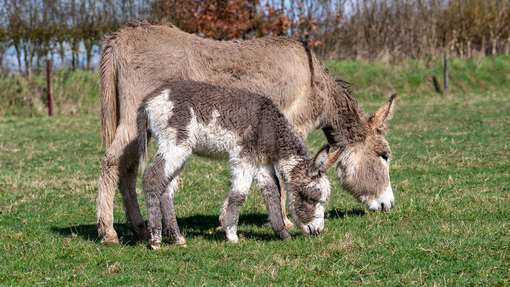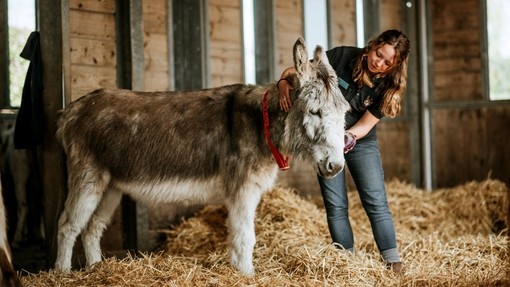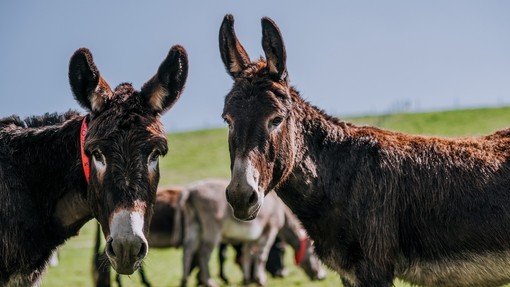How long is the gestation period for donkeys?
Donkeys are pregnant for around 11-14½ months. There are different methods to diagnose an early pregnancy in mares so we recommend that you contact your vet for advice.
Signs of foaling
Usually the birth of a donkey foal is a relatively quick process, so it is essential to be prepared in advance.
As donkey foaling approaches, the mare will become more solitary. The udder will swell and subside for as long as four weeks before finally increasing in size, to the stage where the teats and udder are swollen and the udder is almost indistinguishable from the teats. In the last 72 hours milk usually starts to run.
During the final 48 hours, the pelvic muscles will slacken and the hindquarters will lose muscle tone. ‘Waxing up’ or oozing waxy colostrum from the teats can be observed 24-48 hours prior to foaling. The mare will usually also become restless, stop eating and roll frequently to ease her discomfort.
Foaling
Donkey foaling usually takes around 40 minutes, from the first signs to the point where the foal is free from the mare. Like most animals, donkey foals are usually born at night. Normal presentation is a ‘diving’ position with the head between the forelegs.
In most cases, it is best to stand back and quietly watch, apart from carefully ensuring that when the foal is born its nostrils are free from any membranes or mucus. Most mares deliver lying down but if the mare is standing then you should attempt to catch the foal and hold it close to the vulva to prevent early cord rupture. The cord will naturally remain intact until there is some movement from either the mare or the foal, by which time vital blood will normally have drained from the placenta.
If you have any doubts during the foaling process, call your vet immediately.
Post-foaling
Typically, the mare dries and cleans the foal within the first few hours, which aids the bonding process. Following this, the foal will then try to stand and suckle.
The mare should pass the placenta within the next hour. If no progress is made within two hours call your vet.
Check that the foal’s eyes are open and bright, and that the gums have changed from an initial dark pink to a bright pink colour. The foal’s breathing should be steady and at a rate of up to 60 breaths per minute.
Foals are programmed by nature to search for an udder. Experienced mares will help their foals by circling and nudging in the right direction, whereas maiden mares may not offer the same degree of help. Foals should consume 1-2 litres of colostrum within the first 12 hours of life. It is very important that the foal receives the mare’s first milk (or colostrum) as this contains essential antibodies. The first feed should be within 2-4 hours of birth otherwise they will run out of reserves and start to deteriorate quickly.
An anti-tetanus injection can be given and a foal check should be carried out by your vet the following day.

Caring for an orphaned foal
There are many reasons why a foal might become orphaned, but alternative means of caring for an orphaned foal must be found until the foal reaches at least five months of age.
Finding a nurse mare has many advantages, but they are rarely available. A mare that has just lost her foal is ideal, but success depends on many complicated variables.
There may be no alternative but to hand-rear, in which case, you should consider:
- Hand-rearing a foal is neither easy nor cheap and those involved should be prepared to commit their time and resources. Experienced, conscientious helpers are essential
- A foal can develop poor behavioural characteristics if hand-reared without other animal contact. Sheep and goats make good companions, but the foal should also be allowed to see other equines. When out in the fields (once the foal is over one month of age), it can be joined by a quiet pony or donkey. This companion will act as a role model
- Make sure the foal gets regular exercise, especially as it gets older and stronger. As milk contains very little vitamin D, the foal should be allowed outside regularly in the sunlight. Donkeys exposed to sunlight for at least three hours a day can produce their own vitamin D, which is essential for proper bone development
- The foal should be kept in a warm, dry place, and sheltered from the wind. A clean, loose box with clean bedding is ideal. Ideally the box should have been empty for 2-3 weeks before housing the foal and there should be no incidence of enteric disease associated with the area
- The box and all equipment used should be cleaned, disinfected and/or sterilised. Anyone who enters the box should take the necessary hygiene precautions, particularly in the first 72 hours. The foal can be given covering antibiotics for the first few days if desired; although this is a matter of preference and is not generally advocated.
Foal milk replacer
The mare’s milk is the best option for a foal, but this is not always readily available. Milking a mare is also very time-consuming, and not possible if the foal has been orphaned.
Goat or cow’s milk
You could consider one of these options as they are much easier to obtain, but the composition is different so you will need to counteract this. We recommend:
- 300 ml of cow’s milk
- 150 ml of lime water
- 20 g of lactose/molasses/honey/brown sugar.
Cow’s milk may contain a surprising number of bacteria, so it is advisable to heat it to a high temperature first.
Milk replacers
The ideal formulation contains 15% fat, 22% crude protein and less than 0.5% fibre. Calf milk replacers are not recommended as they are a poor source of protein and often contain antibiotics. Human formulae should also be avoided, as they are not well tolerated by the foal’s digestive system. Poor milk replacers can also cause stunted growth. You could try an artificial milk for foals, such as Aintree foal milk replacer.
Example diets for pregnant and lactating mares
Download our factsheet on example diets for pregnant and lactating mares.




